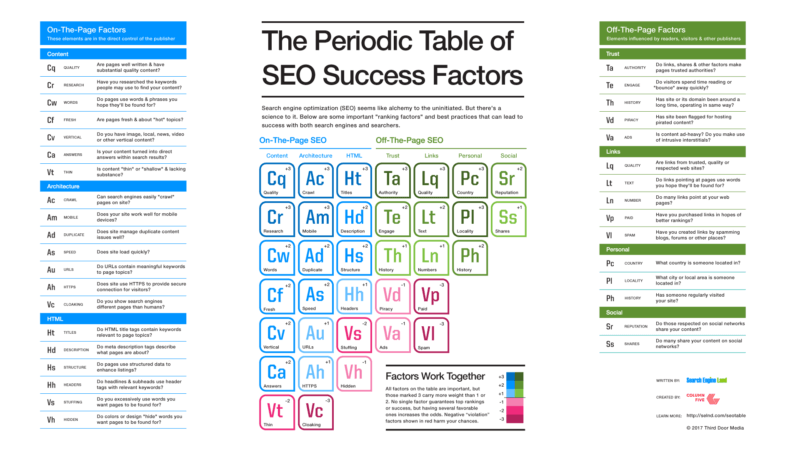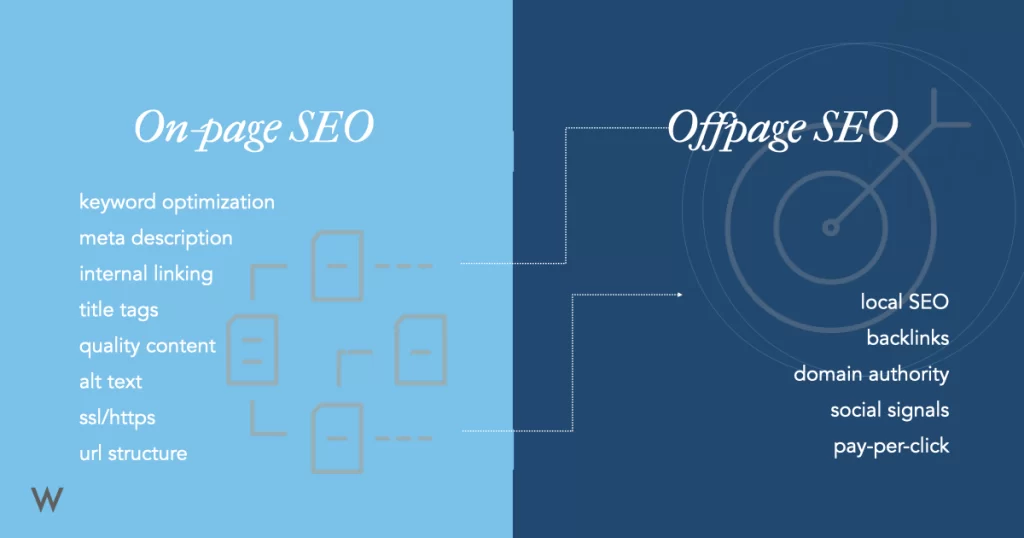SEO Periodic Table: Enhance Your Website Ranking
People open Google to search for you; the website is where they get to know you. Search engine optimization (SEO) is a powerful digital marketing technique that maximizes the number of visitors to your site.
Over the years, Google has gone through many updates to elevate the users’ experience and uses several factors to satisfy its users.
SEO has improved strategically to catch up with Google’s updates.
To help the SEO community with their work, the SEO periodic table was first introduced in 2011 and has been changed a few times till now.
The previous version of the SEO periodic table focuses on the success factor, but the 2019 version focuses on ranking factors.
Before going into detail, let’s first know the way to read SEO periodic table.
How to read SEO periodic table?
The SEO periodic table is broken up into categories of elements. Each box in the chart is color-coded and has a weighted ranking, symbols, element name, and brief description.
The details are placed into four groups on-page SEO, Off-page SEO, toxins, and emerging verticals.
- On-page SEO: Content, Architecture, HTML
- Off-page SEO: Trust, Links, User
- Toxins
- Emerging Verticals
The SEO periodic table focuses on emerging trends and technologies that SEO professionals should be aware of, as they can have value shortly.
Now let’s understand each element in the chat.
Elements of SEO periodic table
Now let’s learn about these elements and how they work together to enhance your website.

On-page SEO: content
Creating high-quality and authentic content matters when you aim to engage, inform, and delight your audience.
So if you want your viewers to stick to your website, you must focus on the following elements while creating content.
1. Quality
Each content published on your website should be informative and valuable, encouraging visitors to stay on your site.
Ensure you interactively deliver the correct information and give attention to EAT while creating content.
2. Research
Do proper keyword research to identify which phrases are essential to creating content. You need to understand what language your audiences use to reach your website.
Using the same language in your content will help you appear on the search engine’s result page.
3. Keywords
After doing keyword research, you need to incorporate it into your content in a reader-friendly manner.
Include the keywords in the title, subheading, and content to make search engines understand your content.
4. Freshness
Search engines prioritize Freshness. To maintain the freshness of the content, you can update your old content that already has gained some authority.
This type of content has changed to improve the ranking when updated with new information.
5. Answer
Searchers seek correct answers, and the search engine continuously improves its algorithm to provide accurate answers.
If you answer users’ questions correctly, your page will be displayed in featured snippets and may reward your content for appearing in voice search.
6. Depth
Write content that gives proper insight into the topic. Content with light information often fails to attract and engage audiences.
Try creating content that can provide more value than your competitors so that you can add new visitors to your site.
7. Multimedia
Creating content that includes images, videos, etc., can help you rank your content. Moreover, these kinds of unique content are appealing and can attract audiences.
If you’re adding video or podcast to your content, you can add a transcript, and if you’re using an image, make sure to use alt-text and caption.
On-page SEO: Architecture
Your website architecture tells Google about the internal state of your site. Consider the following points while formulating the architecture of your website.

1. Crawl
Google uses a bot to read the pages on your site before ranking it on the result page. Crawling is an essential factor that needs to be a focus, and you need to understand how it crawls your website.
Creating the internal link between the relevant web pages helps the bot to crawl through your site and rank web pages.
2. Mobile
Optimizing your website for mobile allows internet users to access the website through their phones.
As many searches are happening from mobile, having a mobile-friendly site will enhance the user experience encouraging them to stay on your site.
3. Duplication
The same content appearing on different websites can be a problem. This needs to be solved using SEO to get rank in search engines.
Using canonical URLs and redirects where multiple page versions can solve problems.
4. Speed
Audiences don’t like to visit the site which has slow loading speed. Your website must load quickly whether visitors view it from mobile or desktop.
You may also like: What is EAT in SEO? How to Improve EAT Score?
As Google considers speed a ranking factor, fast loading of a website can have an SEO advantage.
5. HTTPS
Install HTTPS to make your visitor secure on your website. A website without HTTPS encourages users to leave the site, and the user’s engagement in your site decreases.
Additionally, websites built on a secure platform are ranked on Google’s result page.
6. URLs
Including the keyword in the URL is also a strategy that can be used to rank content. Make sure to use the keywords naturally.
People also read: 12 Necessary Steps to Build a Website for SEO
This allows the search engine and readers to understand what the page is about.
On-page SEO- HTML
Hypertext markup language (HTML) is another crucial element in SEO and is an important ranking signal to Google. The following HTML factors are essential to getting rank.
1. Title
The title should give clear information about the webpage and have keywords in it; only then the HTML signal reaches the search engine.
Using keywords doesn’t just signal Google; attractive keywords encourage internet users to click the link.
2. Description
A meta description is another important factor encouraging people to click the link. It appears below the title and has a brief description of the page.
You may also like: SEO: How to Optimize for Voice Search?
While writing a meta description, you should include keywords and write in a way that attracts people and motivate them to click.
3. Structure
Use Schema markup language to make search engines understand the content and structure of the page.
Using schema tags like a recipe, book reviews, restaurants, software, etc., helps Google to know what your content is about.
4. Heading
The heading is an essential element in content that can help in ranking. Including keywords in the header can help you appear on the result page.
An H1 tag is a title that will have keywords, but using keywords in a sub-heading like an H2 tag can somehow help in ranking.
5. AMP
Accelerated Mobile Page (AMP) helps reduce page loading time and bounce rate. AMP aims to load the webpage on mobile quickly.
Trust
Maintaining a website’s trust is essential to show that your website is worth ranking higher on the result page.
1. Authority
A website that has good authority ranks higher. Getting a good range of management means you’re the thought Leader in your field.
This sends a positive signal to Google and uplifts your ranking on the result page.
2. Engagement
Search engine measures the time visitor spends on the webpage. Creating well-informed and interactive content keeps visitors on your webpage longer and tells Google that your audience likes your content. And this can also be the ranking factor that can support SEO.
3. Reputation
Search engines and users give importance to the reputation of the website. For the new website, it does take time to build a reputation.
You can improve your website’s reputation by publishing relevant content and interacting with your audiences.
Links
It is essential to include an outbound and inbound link on your website. Here are the factors associated with SEO.
1. Value
Links from your industry’s quality, relevant, and reputable websites will likely have a certain weight.
If you want to improve the value of your website, ensure that you’re adding relevant and high-quality links to your pages.
2. Anchors
Including a link from the webpage with similar keywords to your website can also improve your ranking.
3. Backlinks
Backlinks are the links that direct the audiences from other websites to your website. SEO is vital as high-quality backlinks help you rank and improve your authority.
User
Users’ experience is the ultimate factor in ranking your website on the result page. Below are the elements of the SEO periodic table of the user.
1. Country
It’s pronounced that people’s interests differ from country to country. So, if you’re operating in many countries, you must create different content targeting different countries.
2. Location
Local searches are increasing in Google. If you’re a local business targeting local people, you need to put some effort into creating content for locals.
Creating content focusing on locals can improve your ranking.
3. User experience
Think about what your audiences want to learn. Find out their problems and create content to give a straightforward solution to their problem.
If you can communicate with your audiences through content, then that can enhance their experience.
4. History
Analyze the history of your audience, see who is visiting your website regularly, and take the right measure to improve your site’s ranking.
5. Intent
So, when you create content, you should know the user intent to enhance the relevance of your website.
The more relevant your web pages are to your audiences, the more often you get ranked and displayed on the search engine result page.
Toxins
Till now, we’ve learned what you’re supposed to do to get your website rank. Here are the points that you should not be doing.
- Cloaking: Don’t display different pages than yours to the search engines.
- Schemes: Don’t use any black hat trick link spam blog to improve ranking.
- Stuffing: Don’t use a lot of keywords in your content.
- Hiding: Don’t hide keywords from your viewers.
- Piracy: Don’t put other’s content on your website.
- Intrusive: Don’t bombard the users with pop-ups.
Emerging verticals
Here are new types of content that are gaining popularity among users.
- Voice: As people heavily use mobile, voice search has increased massively.
- Local: Listing, reviews, maps, and NAP ( Name, Address, Phone number) are essential for local businesses as local search is increasing.
- Image: Images are gaining popularity in SERP
- Video: Searchers are looking for interactive videos for answers.
All the mentioned elements are the do’s, don’ts, and emerging aspects of SEO that can help you improve your ranking.







